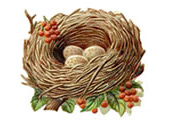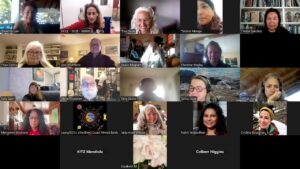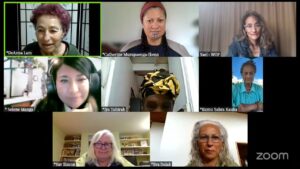 “This is my Moon Flow,” I said to Ellah, who was about 4 at the time, when she saw me changing a pad. I never saw my Mom changing pads, and hence committed to not hiding my natural flow from my daughter. Without my flow, my girl would not have been born… How could this be anything but a source of joy in my ability to give birth? An ability she will one day share!
“This is my Moon Flow,” I said to Ellah, who was about 4 at the time, when she saw me changing a pad. I never saw my Mom changing pads, and hence committed to not hiding my natural flow from my daughter. Without my flow, my girl would not have been born… How could this be anything but a source of joy in my ability to give birth? An ability she will one day share!
“All women flow with the moon,” I added, “and you, too, will flow when you become a woman.” Ellah smiled with the promise, and at four years of age this was enough. I didn’t refer to the flow as “blood” until much later, since I didn’t want Ellah to associate it with an “Ouwy.” The purpose with young children, both girls and boys, is to introduce, and talk about, this natural bodily function in the same neutral way as you do when talking about eating. Gradually, as the child matures, it is good to tie the flow to its purpose, which is a woman’s ability to give life.
If you find that you have some charge about your menstruation (such as physical or emotional pain) it is best not to introduce the subject to your child until you work through your difficulty and gain some balance for yourself.
Generally, it is best not to bombard children with information, but to wait for their questions. When Ellah was about seven, she asked me where does the Moon Flow come from? My answer was inspired by the Waldorf educational approach, and I explained that the Moon Flow is “Mom’s Nest.”
“Mommy’s Nest???” she asked in amazement.
“Yes,” I said. “When a Mama bird prepares for a baby bird to be born, she makes a nest. She flies in the forest and collects leaves, feathers, boughs, branches, and bits of fluff, and she weaves a nest for the baby bird to comfortably lie in.”
“Well…” I continued, “it’s the same with me. And with all women! Every month a woman’s body prepares a nest in her tummy, where a baby can grow. Her wise body gathers tissue and blood from inside her, and makes a warm and comfortable nest. Then, if no baby starts to grow, there is no need for the nest. So Mamma’s wise body sends the nest out in a big whoosh. That’s why the flow is red, because it’s made of all the good, nourishing blood that was ready to help the baby grow.”
“Every month,” I shared with my daughter, “I thank my body for being such a miracle, and for knowing how to make a baby grow inside… I also thank it for the wisdom of letting go of the nest, when I don’t need it…” Ellah was fully satisfied. She had a clear picture in her mind, and the Moon Flow made sense to her.
Telling your child a story of this nature doesn’t only encapsulate the physical facts associated with menstruation. It allows you to start instilling the awe, which our bodies deserve for their amazing abilities. Beyond that, you are actively bucking the cultural current of taboo and shame around menstruation. You are raising a girl or a boy who will have a different narrative with which to counter the cultural beliefs when they encounter them.
____________________________________
© 2011 DeAnna L’am, All Rights Reserved



4 Responses
That is such a fabulous and creative way to make a daughter comfortable with the discussion. I never realized it could be that good. Thanks for this blog.
I think it’s a great idea that you’re sharing and not hiding anything because hiding makes it seem secretive and shameful…
However, moon flow? That’s like calling a vulva a hoo-hoo.
Heather,
I’m glad you see the benefit in talking openly about menstruation with our daughters.
The term Moon Flow is, to my mind, as accurate as it is poetic:
Women’s bodies mirror the rhythm of the moon.
The average menstrual cycle is 28.5 days, which is exactly the length of the moon’s monthly journey around the earth.
We flow from our wombs, and we do so synch with the moon…
I like using the term Moon Flow, and so does my daughter.
I don’t have any investment, though, in anyone else using it.
As for calling a vulva “hoo-hoo’ – that’s certainly not my choice, but if anyone chooses to so — so be it.
If you are interested in reading about alternative names for our reproductive organs, both female and male, here is a link to an article I wrote about my own practices:
https://deannalam.com/2011/05/mom-do-men-have-sacredness-in-their-body/
Enjoy!